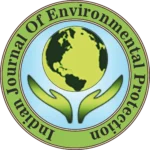IJEP 41(10): 1166-1170 : Vol. 41 Issue. 10 (October 2021)
Navneet Kumar1 and D.K. Sinha2*
1. Teerthanker Mahaveer University, Department of Chemistry, Moradabad – 244 001, U.P., India
2. K.G.K. (P.G.) College, Department of Chemistry, Moradabad – 244 001, U.P., India
Abstract
Drinking water pollution causes health problems which can be prevented by taking appropriate actions. Water quality index (WQI) is effective way to communicate and parameterize quality of water. The data obtained through quantitative analysis of water is measured up against WHO water quality standards to calculate water quality indices. The purpose is to assess river water pollution and effect of monsoon at Moradabad (Uttar Pradesh). Water quality index (WQI) for Gagan river water at thirteen different sites at Moradabad has been calculated for pre-monsoon period and after onset of monsoon with the help of estimated values of seventeen different physico-chemical parameters and WHO water quality standards. River was polluted at all the sites that were studied for both periods. At almost all the river water sites, the water quality shows some improvement after the onset of monsoon, however, river water was still severely polluted. Higher estimated values of various parameters on the basis of water quality indices also support and verify the results of river water pollution. Mixing up different effluents with river water multiplies the river water pollution. People that are exposed to such severely polluted water are threatened and water quality management is imperative in the catchment area of study.
Keywords
Parameters, Index, Quality rating
References
- Kolekar, S.S. 2017. Physico-chemical status of Bhima, Bhama and Indrayani river flowing through khed taluka, Rajgurunagar, Pune district. Poll. Res., 36(2):340-342.
- Kumar, N. and D.K. Sinha. 2018. Seasonal variation of iron in underground drinking water sources in and around Moradabad city, Uttar Pradesh, India. Int. J. Appl. Eng. Res., 13(13):11062-11068.
- Singh, S., A. James and R. Bharose. 2017. Studies of water quality in monsoon season at Yamuna river, Allahabad, India. Eco. Env. Conser., 23(4): 2319-2322.
- Bandal, J. 2017. Assessment on impact of mass bathing on water quality of Godavari river during Kumbh mela in Nashik city, Maharashtra, India. Poll. Res., 36(3):610-618.
- Rajput, S., S. Arora and R. Kaur. 2019. Assessment of spatio-temporal variation in pond water quality-A case study. Indian J. Env. Prot., 39(3):263-270.
- Singh, K.K., et al. 2018. Physico-chemical characteristics of water in Khumapact lake, Manipur. Indian J. Env. Prot., 39(10):836-847.
- Sakamoto, M., et al. 2019. Water pollution and the textile industry in Bangladesh : Flawed corporate practices or restrictive opportunities? Sustain-ability J., 11:1951.
- Khan, N., A. Mathur and R. Mathur. 2005. A study on drinking water quality in Lashkar (Gwalior). Indian J. Env. Prot., 25(3):222-224.
- Sinha, D.K. and A.K. Srivastava. 1995. Physico-chemical characteristics of river Sai at Rae Bareli. Indian J. Env. Health. 37(3):205-210.
- Madhuri, U., T. Srinivas and K. Sirresha. 2004. A study on groundwater quality in commercial area of Visakhapatnam. Poll. Res., 23(3):565-570.
- Yashoda, T., et al. 2014. Pre and post-monsoon variation in physico-chemical characteristics in groundwater quality of Mindi industrial area, Visakhapatnam, India. Int. J. Env. Sci., 4(4):746-753.
- Singh, P.K. and P. Shrivastava. 2016. Assessment of water quality of Uppar lake, Bhopal (M.P.). Int. J. Env. Sci., 7(2):164-173.
- Pradhan, S.K., D. Patnaik and S.P. Rout. 2001. Groundwater quality index for groundwater around a phosphatic fertilizer plant. Indian J. Env. Prot., 21(4):355-358.
- Sinha, D.K., S. Saxena and R. Saxena. 2004. Water quality index for Ram Ganga river at Moradabad. Poll. Res., 23(3):527-531.
- Sinha, D.K. and R. Saxena. 2006. Statistical assessment of underground drinking water contamination and effect of monsoon at Hasanpur, J.P. Nagar (Uttar Pradesh, India). J. Env. Sci. Eng., 48(3):157-164.
- Ramamurthy, N., et al. 2015. Assessment of water quality parameters of Koilsagar project in Mahabubnagar district, Telangana, India. Int. J. Env. Sci., 5(6):1134-1139.
- APHA. 1998. Standard method for examination of water and wastewater (20th edn). American Public Health Association, Washington DC.
- Merch, E. 1974. The testing of water. Darmstadt, Germany.
- Horton, R.K. 1965. An index number system for rating water quality. J. Water Poll. Cont. Fed., 37(3): 300-306.
- Tiwari, T.N. and M. Mishra. 1985. A preliminary assignment of water quality index of major Indian rivers. Indian J. Env. Prot., 5 (4):276-279.
- WHO. 1984. Standard methods for drinking water (vol 1). World Health Organization, Geneva, Switzerland.
